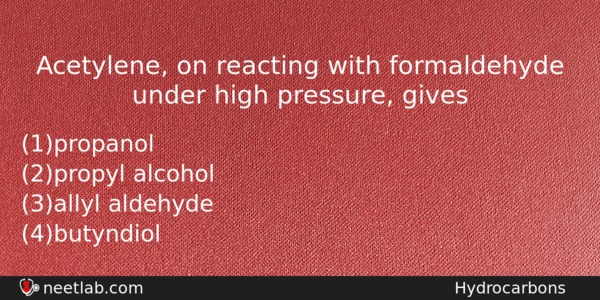| ⇦ | 
| ⇨ |
Acetylene, on reacting with formaldehyde under high pressure, gives
Options
(a) propanol
(b) propyl alcohol
(c) allyl aldehyde
(d) butyndiol
Correct Answer:
butyndiol
Explanation:
HC ≡ CH + HCHO (Acetylene) → HC ≡ C – CH₂OH (Formaldehyde)
HC ≡ C – CH₂OH + H – C = O → HOCH₂C ≡ CCH₂OH ( But – 2- yn-1,4-diol)
Related Questions: - Oxidation number of Fe in Fe₃O₄ is
- Three dimensional molecules with cross links are formed in the case of a
- Plaster of paris is used
- The oxyacid of phosphorus, in which phosphorus has the lowest oxidation state, is
- Hardness of water due to presence of salts of
Topics: Hydrocarbons
(84)
Subject: Chemistry
(2512)
Important MCQs Based on Medical Entrance Examinations To Improve Your NEET Score
- Oxidation number of Fe in Fe₃O₄ is
- Three dimensional molecules with cross links are formed in the case of a
- Plaster of paris is used
- The oxyacid of phosphorus, in which phosphorus has the lowest oxidation state, is
- Hardness of water due to presence of salts of
Topics: Hydrocarbons (84)
Subject: Chemistry (2512)
Important MCQs Based on Medical Entrance Examinations To Improve Your NEET Score
18000+ students are using NEETLab to improve their score. What about you?
Solve Previous Year MCQs, Mock Tests, Topicwise Practice Tests, Identify Weak Topics, Formula Flash cards and much more is available in NEETLab Android App to improve your NEET score.
Share this page with your friends

C2H2+2HCOH=OHCH2CCCH2OH